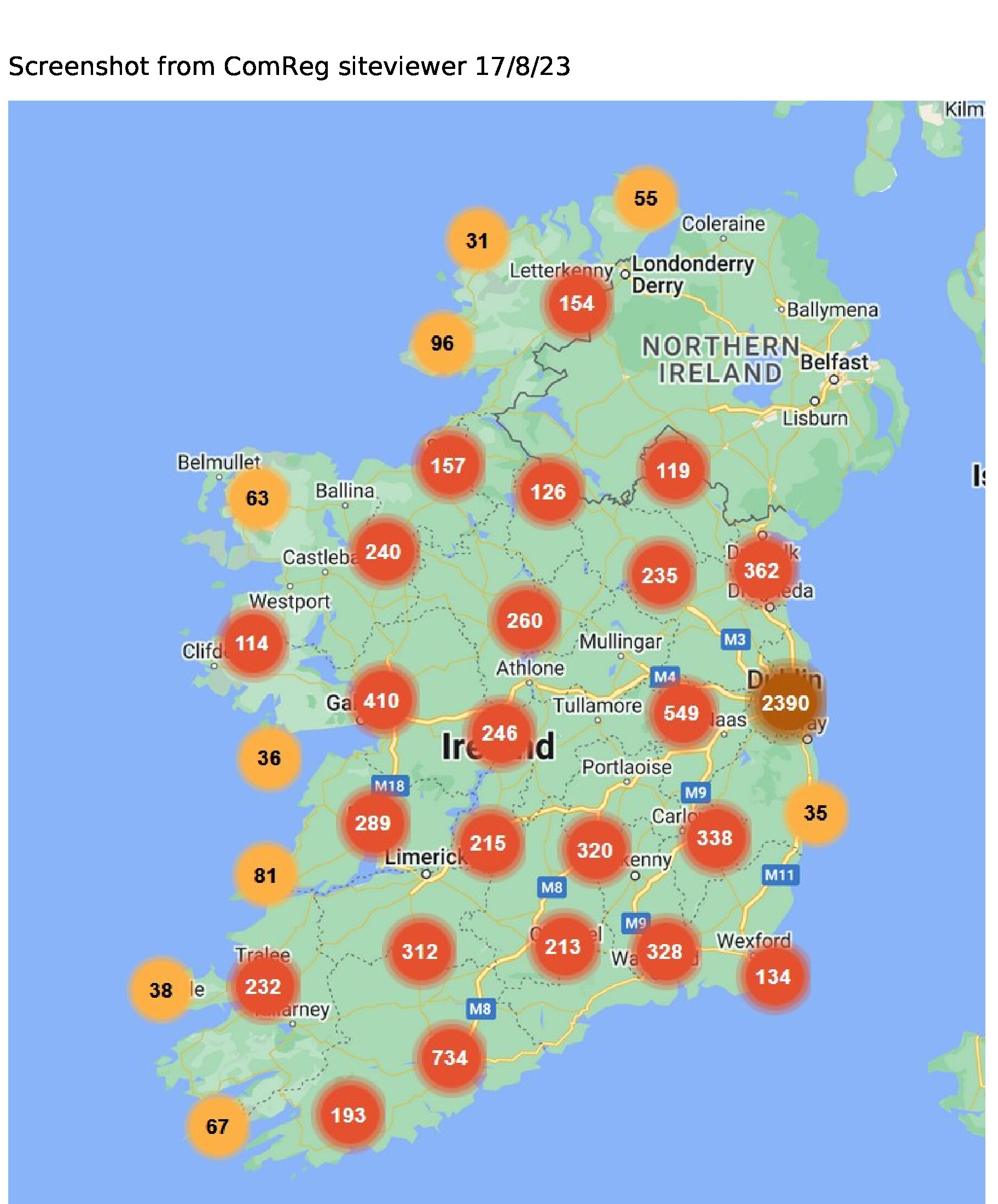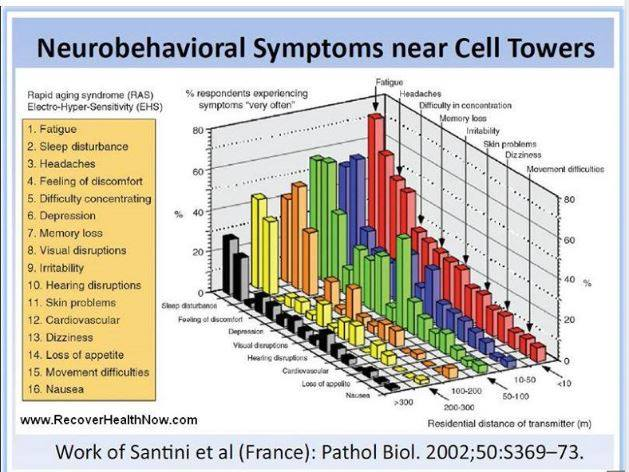Research shows higher rates of illnesses and cancers in those living near mobile masts and base stations. One study has shown that the risk of developing cancer for those living within 400 metres of mobile phone antennae in comparison to those living outside this area, was three times as high. (See Studies Here)

As at August 2023, the ComReg siteview maps shows over 9,000 mobile phone base station sites in Ireland. New masts and base stations are not uploaded to the Siteviewer for some months after being installed so actual number of sites and antennas could be greater than shown.
These will be masts with antennae, or antennae on roofs, sides of buildings, water towers etc. transmitting microwave radiation constantly for 2G (GSM), 3G (UMTS), 4G (LTE) and now 5G (NR) * and wireless broadband from a number of mobile phone and telecommunications companies. The map does not include TETRA (emergency services), local wireless broadband from private companies, or wifi hotspots which are present in most cities and towns.
A mobile phone mast is the structure that carries the antennae and other equipment. An antenna is the device that transmits and receives wireless signals between them and mobile phones and devices. They are commonly rectangular in shape, mostly white.
TETRA antennae which are placed on Garda station masts are long thin metal usually sticking out the top. TETRA is the secure telecommunications network for emergency services.
The round drum shapes on many masts are repeaters which transmit and receive signals between mobile masts. Not all antennae are installed on masts, as many are placed on buildings or in monopoles so are not as conspicuous as large mast structures. Small antennae can be hidden. Some telecoms structures are disguised to look like trees to blend into the environment.
Despite recommendations by experts and the EU Resolution in 2009 that mobile phone antennae should not be placed near schools, hospitals, homes, places of worship, these antennae are now being placed almost anywhere the companies want them. https://www.europarl.europa.eu/sides/getDoc.do?type=TA&reference=P6-TA-2009-0216&format=XML&language=EN
With the introduction of more technology, the demand for faster speed with 3G, 4G and wireless broadband, and 5G we, and our children, are being increasingly exposed to more and more harmful radiation, as more masts and antennae are erected.
For up to date information on new masts and planning applications, see Mast Watch Ireland.
The more we use smart phones and wireless devices to communicate, work, access streaming services, the more bandwidth is needed to facilitate these networks. The more people using the networks, the less bandwidth there is to share between them, so base station technologies are upgraded and areas intensified with more antennae and harmful microwave radiation is therefore increased. This applies to all generations of mobile phone technology, 2G, 3G and 4G – not just 5G.
While there is currently a lot of discussion and protest about the new 5G networks, and although 5G (mostly microwave and millimeter wave in the future) will be used for much more than just mobile communications and are a serious cause for concern with wide spread installations and uses, it has to be said that if we continue to rely on and use wireless smart phones and smart technology, then the infrastructure will continue to go up and extend.
In the last few years masts, monopoles and antennae for increased 2G, 3G and 4G coverage, as well as the new 5G network are being installed across the country at an alarming rate. Many of these installations do not require planning permission as they are being fixed to existing structures, are below the required height for planning permission, and most are granted under new legislation which does not allow for public consultation – Section 254 Licences normally for street furniture are not being granted for telecommunications masts. Locals are not being informed and many people are not aware of health risks. Further removal of public rights to oppose masts are being planned
Scientific Studies
One Study Finds Cell Tower Radiation Is Linked To Type Of Damage In Human Blood That Predicts Cancer
A 2017 published study comparing people living close (within 80 meters) and far (over 300 meters) from a cellular antennas found that the people living closer to the cellular antennas had statistically significant effects- increases in blood damage considered biomarkers predictive of cancer. Researchers measured the radiofrequency (RF) radiation exposures to the two groups and found that although the levels were within government limits, the people living closer to the cellular antennas had a much higher RF exposure.
Impact of radiofrequency radiationon DNA damage andantioxid ants in peripheral blood lymphocytes of humans residing in the vicinity of mobile phone base stations (Zothansiama et al, 2017)
Through blood tests, researchers found statistically significant findings in people living closer to mobile base stations – who had higher RF levels in their bedrooms than the control group.
The exposed group had statistically significant:
- Higher frequency of micronuclei.
- Attrition in antioxidant glutathione concentration, activities of catalase and superoxide dismutase.
- Rise in lipid peroxidation a product of free radical oxidation.
“The present study demonstrated that staying near the mobile base stations and continuous use of mobile phones damage the DNA, and it may have an adverse effect in the long run. The persistence of DNA unrepaired damage leads to genomic instability which may lead to several health disorders including the induction of cancer, ” concluded the study authors.
Biological effects from exposure to electromagnetic radiation emitted by cell tower base stations and other antenna arrays- B. Blake Levitt and Henry Lai https://www.radiationresearch.org/images
“The siting of cellular phone base stations and other cellular infrastructure such as roof-mounted antenna arrays, especially in residential neighborhoods, is a contentious subject in land-use regulation… Both anecdotal reports and some epidemiology studies have found headaches, skin rashes, sleep disturbances, depression, decreased libido, increased rates of suicide, concentration problems, dizziness, memory changes, increased risk of cancer, tremors, and other neurophysiological effects in populations near base stations. The objective of this paper is to review the existing studies of people living or working near cellular infrastructure and other pertinent studies that could apply to long-term, low-level radiofrequency radiation (RFR) exposures” Biological effects from exposure to electromagnetic radiation emitted by cell tower base stations and other antenna arrays
Study of the health of people living in the vicinity of mobile phone base stations:
I. Influences of distance and sex (2002) R. Santini, P. Santini, J.M. Danze, P. Le Ruz, M. Seigne

See more up to date Studies
